Walker / Technical Brain, (small) TAD room
This is the 2nd Walker room that I visited. The first, with the larger TAD speakers, had too much uncontrolled bass and was not interesting.
This room here, however, WAS interesting. [and not just because this was where Lloyd Walker was hanging out :-)]

The smaller TAD speaker’s sound was filling the room quite well without overloading it. Lloyd was playing an LP with the famous track from the Burmester CD about the diamond mine trains in Africa. OK. We’ve all heard this track like a million times, right? The singer’s voice is a combination of showman, stylized story telling and real [spooky] anguish sometimes slips through.
Well, not with this system. There was hardly any micro-dynamics or inner-detail – hardly any note attack and decay at all. There was NO emotion to the voice. You could understand the words, but not much was accessible beyond that.
This is much more interesting to me because we are very familiar with most of the components of this system.
The Walker turntable is one of the, if not THE [which I can argue I think convincingly], highest resolution turntables in the world. No problem with micro-dynamics here.
The AirTight PC-1 Supreme cartridge, Neli tells me, is highly regarded and retails at the $9,000 range.
The Silent Source cables we used to carry here, and we are somewhat familiar with them. In addition, recently [well, this year some time] we did a shootout here with their speaker cables. They are not bad at all [they seem to like to be warmed up a little, more than most cables, so if you do a shootout, play some music through them before the shooting begins], and in the same stadium as, say, the Nordost Valhalla. Perfectly capable of decent micro-dynamics.
But there was like NONE in this system.
[I am ignoring the rack and amp stand.. even the most terrible micro-dynamic-absorbing but quite popular racks and amps stands could not do THIS much damage to the micro-dynamics… and they would do it in an uneven fashion across the freq spectrum, causing tonal anomalies but leaving micro-dynamics alone at various frequencies for us to hear, for the most part]
So we are down to the Technical Brain TBC Zero Pre-Amplifier and a Technical Brain amp… and the TAD speakers. One of these two brands is INcapable of rendering micro-dynamics, and I would say, incapable of rendering any fine detail at all.
Which one is it?
Don’t know for sure, but let’s look at both for a second. We heard Technical Brain electronics at CES in the big Magico room. This is inconclusive because that system had a lot of problems – and close listening [beyond gross evaluations] did not seem to be of interest given the limited time available at these shows.
We’ve heard TAD speakers at these shows many, many times. But I’ve just realized in the last few days that I’ve never heard them on anything but muscle amps – designed to produce loud impressive noises. Never with an amp designed to reproduce music in its entirety [see list below for possible candidates if we must stick with solid-state i.e. because the speakers need a lot of power].
My guess is that it would be hard for a speaker to be designed to have no micro-dynamic capability, esp. speakers that are so lovingly designed [I do not hold for that “TAD is just a Pioneer” talk, anymore than I do for Lexus being just a fancy Toyota or Esoteric being a fancy Teac.].
On the other hand, it is in fact quite common for amps to only be capable of the brute force, “let’s go for the note magnitude and none of its structure” approach.
So we are going to put Technical Brain amps [and Levinson by special request :-)] into our list, last found in the thread at:
https://audiofederation.com/blog/archives/656
// MICRO DYNAMICS < - less .... more ->
VTL – Soulution – Technical Brain – McIntosh – BAT – Levinson – CAT – ARC – Pass – Boulder – Krell – FM Acoustics – Spectral – Halcro – MBL – Ayre – Sanders – Goldmund – Edge – Vitus
Again, this is somewhat inexact; we are stereotyping an entire brand, which means it is more or less true but that there are probably exceptions – and you could probably swap any 2 or 3 adjacent slots in the list with each other and still be more or less on the money.
Let’s talk about what Micro-dynamics is so that everybody knows what we are talking about. Micro-dynamics is related to inner detail which is related to fine detail. It is how we can listen to a voice and hear what kind of feelings they are trying to communicate…. peevishness, loss but hope for the future, love with hope for passion someday… simple and complex emotions like these are communicated through very subtle voice [and instrument cues by the best musicians] – and are an integral part of real music.
It would be my guess that most people who buy high-end stereo systems want this – and I know for sure that very few get it. The muscle systems they are sold instead are great for keeping the more sensitive spouse out of the listening room, and great for showing off to people who do not have to buy or listen to the system day in and day out.
Here are some graphs I drew in photoshop. They look like poop but they, hopefully, help illustrate what we are talking about

The original note in all its glory [OK. I know. But use your imagination :-)]
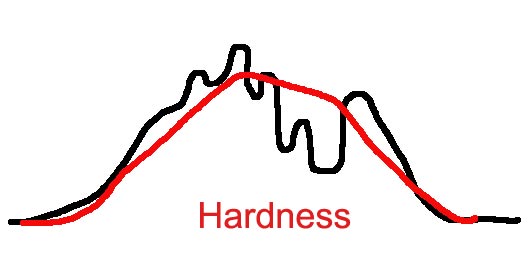
Hardness: a loud note that does not have enough micro-dynamics to relieve the impact of pressure on the ear drum. [I think what we call shrill, Jim, is hardness at high frequencies]. Note that to avoid shrillness, most amps without micro-dynamics are rolled off severely in the higher frequencies.
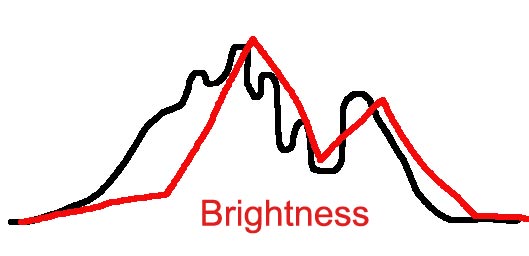
Brightness: too sharp of note transitions, especially in the upper frequencies.
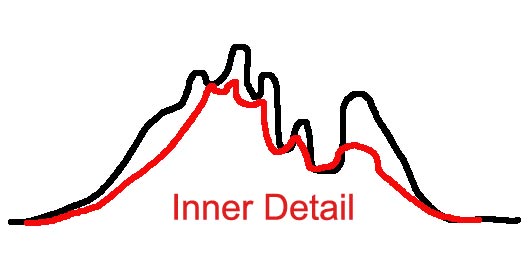
Inner Detail: We will define this as micro-dynamics that has too little magnitude [i.e. just a hint of micro-dynamics] [agree? disagree?]
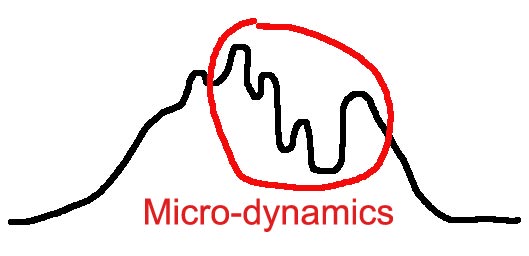
Micro-dynamics: The actual way notes appear in the wild, with lots of bumps [abrupt changes in magnitude – and other things like freq and related freq (harmonics) all with lots of bumps]
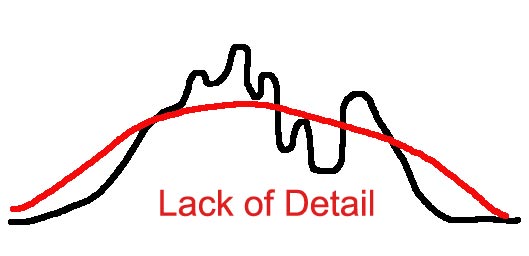
Lack of detail: note transitions too rolled off, soft, rounded,…

Too much detail: note transitions too abrupt [but not sharp], note envelopes rise and decay too quickly.
As these charts indicate [well, they TRY to indicate] micro-dynamics is really all about accuracy.
The fact that the industry describes ‘accuracy’ as having the measured magnitude [the top point? or weighted average most likely] of a reproduced note being within a few dB of the original note – is a wildly gross simplification that causes no end of grief to people who want their reproduced music to sound like music, and not simple sin waves [which have no bumps, hence no need to think about micro-dynamics]
Concluding… this system is a Muscle output section on a wonderfully high-resolution, perhaps Magical, front end. Lowest common denominator rules in system design, and the overall result is a Muscle system.

Dear Mike
Thanks for graph, I think graph is a good way for discribe our ideas about sound, i see common view between those you paint with my paint about meaning of macro and micro linearity.
measurement just measure “(micro*micro linearity) + (macro*Macro Linearity)” and they can not show importance of micro linearity.
I really like to see Vitus in Audio Federation 😉
I think the graphs describe your ideas pretty well. The interesting question now is: how does this relate to what is really happening? If you would measure the sound pressure in the room and compare it with the original electrical signal, say before it enters the amplifier, what would you see? Are there any objective measures that would capture the essence of what you are describing?
Dear Amir,
Can you include your graphs here (I think you can type or paste the HTML that points to the .jpg directly into comments here) or include a link from a comment to them on your blog?
I remember our discussion was interrupted a few month back and I haven’t got back to it [sorry] but I am still having a problem with your conceptualization of linearity versus mine. If we just look at dynamic linearity, at, say a somewhat arbitrarily chosen 0.3dB, then we would have a graph of (Micro Linearity Accuracy (0.3dB) x Freq). to describe how well something is able to handle small dynamics up and down the freq spectrum. Agree? Disagree?
Take care,
-Mike
Hi umea101,
The real problem is that there is, and probably never will be, funding for this type of thing – so somebody has to dedicate their time, resources and expertise to creating testable, verifiable models of how our brains process music and how that relates to the technology we use to (re)produce music.
Nordost is doing a little with this – and perhaps if it turns out to give them a marketing advantage, then others with deeper pockets will continue the investigation.
Considering that we used a Radio Shack freq spectrum analyzer, I think it was, to measure the differences in power cords here at Audio Federation almost 10 years ago, and people are still saying power cords make no difference, just shows how any significant work and deeper understanding in this area is only going to benefit a very few people [mostly the type of people who like to read blogs like this]. I.E. it will not be rewarding financially [as opposed to modeling in other areas, for example, how news affects stock traders or advertising affects purchases, etc.].
But if one wrote up a proposal to investigate and model psycho-acoustical aspects of advertising messages on purchasing behavior, then there might be funding for THAT 🙂 during which effort one might be reasonably(?) expected to investigate things like these kinds of graphs posted above [right now, it appears that the models they use say that the more irritating the acoustical component of the ad is, the more a person will become aware of and remember the ad, albeit with a deep abiding hatred ;-)]
Thanks for your post [and I know I did not answer it – but I will try to come back sometime when there is more time, perhaps in a new post, and talk about how we might further investigate and pin down the ideas behind these graphs].
Take care,
-Mike
Mike – No argument about Levinson position vis a vis Krell & Edge. thx. I’ll take the rest on faith since I’ve heard none of the others.
Graph serves well to clarify your use of terms…well done. (Good teaching moment too; have you thought of higher office?)
Hi Jim,
Higher office… higher office… You mean move my office higher? We’re at 7200 feet now. Maybe into the Sierras? Mt. McKinley? The Himalayas???
😉
Take care,
-Mike
Don’t ask me what I’m doing on this site: http://herbiesaudiolab.net/sqfaq.htm
[Actually, I’m readng about “Isolation Feet FAQ’s made by HERBIE] However, I thought he came up with a succinct statement that comforftably fits with your graphs and, to give credit where credit’s due, I hereby quote from the FAQ:
Q: Doesn’t too much detail give you a dry, analytical sound?
A: An “analytical” sound is the result of some but not enough detail resolution. In such cases, subtle micro-detail and transients are lacking; major notes and dynamics are present but subharmonics and ambient indicators are weak. With sensitive and accurate detail resolution, you don’t have to sacrifice “smoothness” to get detail, and vice versa.
Hi Jim,
That is indeed a nice way to put it. A little out of place w/ respect to the rest of the FAQ, but nice nonetheless.
[Ugh. Ate too much for supper…. :-)]
Take care,
-Mike
Dear Mike
Thanks for care
OK, i will publish it , just give me time.
regards
Amir